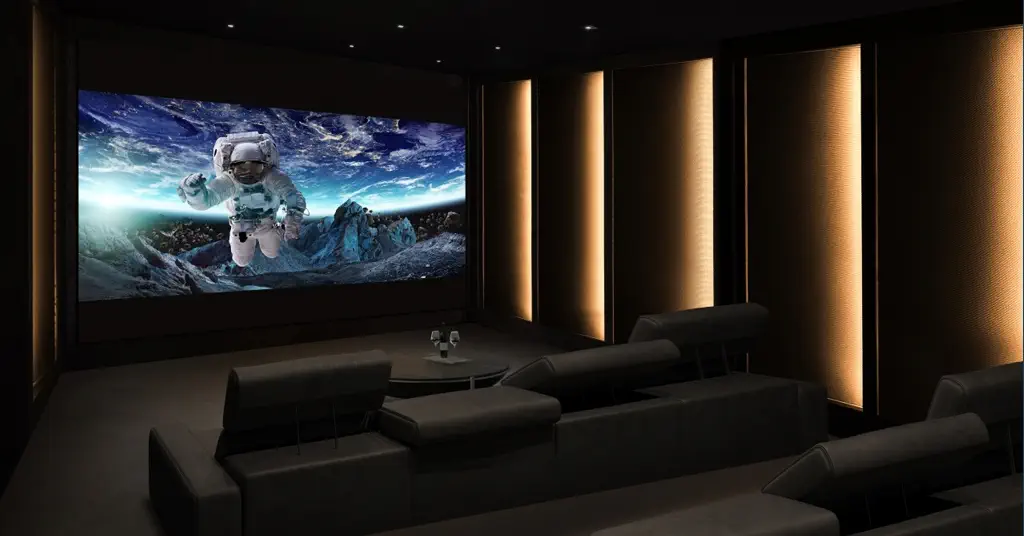Why Choose an LED Screen for Your Home Theater?
As an important part of the home theater, the display system directly affects your viewing experience. At present, there are three main display devices for home theaters, namely laser projection devices, liquid crystal display devices and LED screens. These three different home theater display systems provide completely different viewing effects, and you can choose according to your actual situation. If you want to upgrade your existing home theater setup or want to redeploy a home theater system, we recommend that you choose LED screen as your home theater display system.
Table of Contents

Advantage of home theater LED screen
Better screen picture quality
LED screens can provide better image quality than other types of screens such as LCD and plasma screens, laser projection screens. The LED screen has a wider color gamut and provides true blacks. In particular, home theater screens made of MicroLED screens can arrange light-emitting pixels at small pitches. Whether it is self-illumination brightness, color contrast, color gamut or refresh rate of dynamic images, it far exceeds the effect of other different types of home theater display screens.
Longer service life
The current service life of home theater LED screens can usually reach more than 80,000 hours, and the service life of LED screens of some well-known brands or special customized projects can reach 100,000 to 120,000 hours. The life of the light source of a laser projector is usually about 30,000 hours, and the brightness of the laser light source will be reduced from 100% to 80% of the work efficiency. The service life of LCD screens can usually only be maintained at about 50,000 hours, which is much lower than that of LED screens. The long service life can reduce the average cost of use of the home theater, that is to say, if you use LED screen as your home theater display device, the more you use it, the more you save money.
Wider viewing angle
When the brightness in the horizontal and vertical directions is half of the brightness in the normal direction of the LED display, the angle between the observation direction and the normal of the LED display is called the horizontal viewing angle and the vertical viewing angle, and generally ± means left and right and up and down How many degrees each. The LED screen’s surface-mount luminous pixel technology determines that it can have a wider viewing angle than laser projectors and LCD screens. In the indoor environment, the horizontal and vertical viewing angles of the LED screen can both reach 120°. This means that when you and your family watch video and audio programs in different corners of the home theater room, you can enjoy a good viewing experience.
Lower energy loss
Taking the traditional LCD display screen as an example, the light valve function of the liquid crystal in the LCD must be based on polarized light. The light passes through the upper and lower polarizers and loses about 57% of its brightness. In addition, in order to display the color effect, LCD needs to use color filters, and this layer of film directly causes the overall light efficiency to drop by more than 70%. Coupled with other losses, the utilization efficiency of the LCD display on the brightness of the backlight is only 8% at most, that is, 92% of the energy is wasted. Compared with LCD, the pixels of Micro-LED are self-luminous and do not need to pass through polarizers or color filters, so their photoelectric conversion efficiency is much higher than that of LCD. In the case of displaying the same picture, the power consumption of MicroLED is only about 10% of that of an LCD screen.
Wider range of applications
In addition to simply watching movies and TV programs, home theater can also be used in games and work fields. Usually these projects cannot be carried out normally when using laser projection equipment or liquid crystal display equipment. LED screen integrates most of the common signal transmission channels and related software application functions, fully capable of supporting your daily games and work items. In a sense, your home theater can be expanded into a multi-functional modern office and entertainment place when using LED screen.

Common home theater LED screen types
There are 5 types of common home theater LED screens, namely Full-array LED screen, Edge-lit LED screen, QLED screen, OLED screen and MicroLED screen. These 5 different home theater LED screens have great differences in display performance, service life, and price. Under the premise of a comprehensive evaluation of various relevant indicators, we recommend that you use MicroLED screen as the first choice for your home theater display device. If you want to know more about the differences between these 5 different home theater LED screens, please click the button below to view.
Conclusion
LED screen is the first choice for home theater display system. Compared with other different home theater display devices, LED screen can provide better picture quality, longer service life, wider viewing angle, lower energy loss and wider application fields.
With the advancement of technology, more and more high-performance LED screens will be used as the main display device of the home theater to satisfy your experience of the film and television screen.
Galaxyav is a professional home theater audio and video solution provider. We manufacture various types of home theater LED screens and provide one-stop home theater solution services to global customers. If you have this demand, please contact us. We will provide free consultation and project quotation.
